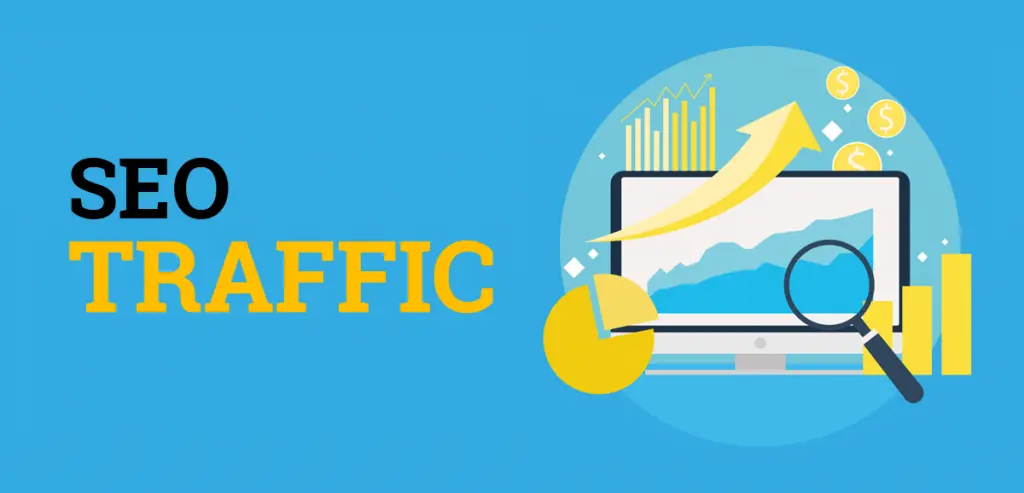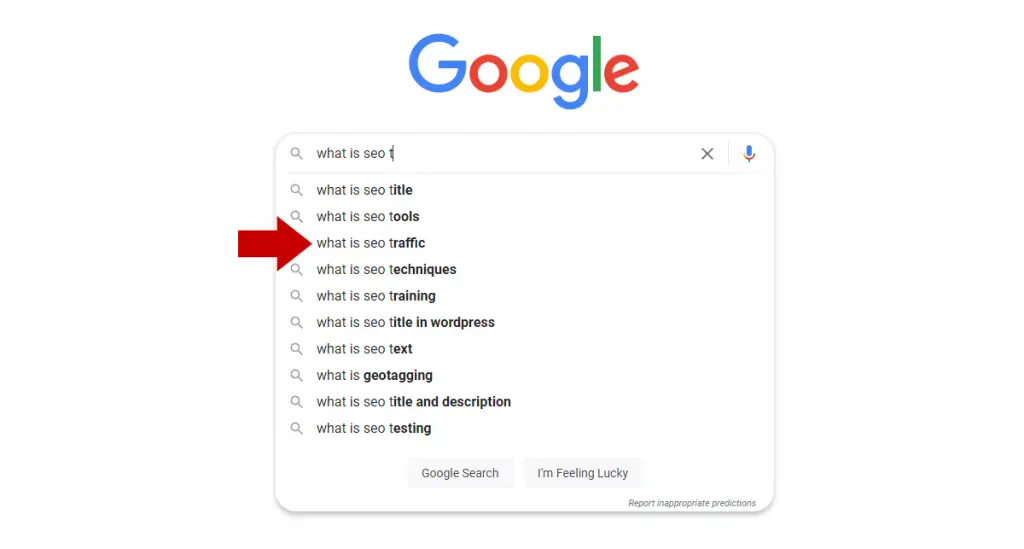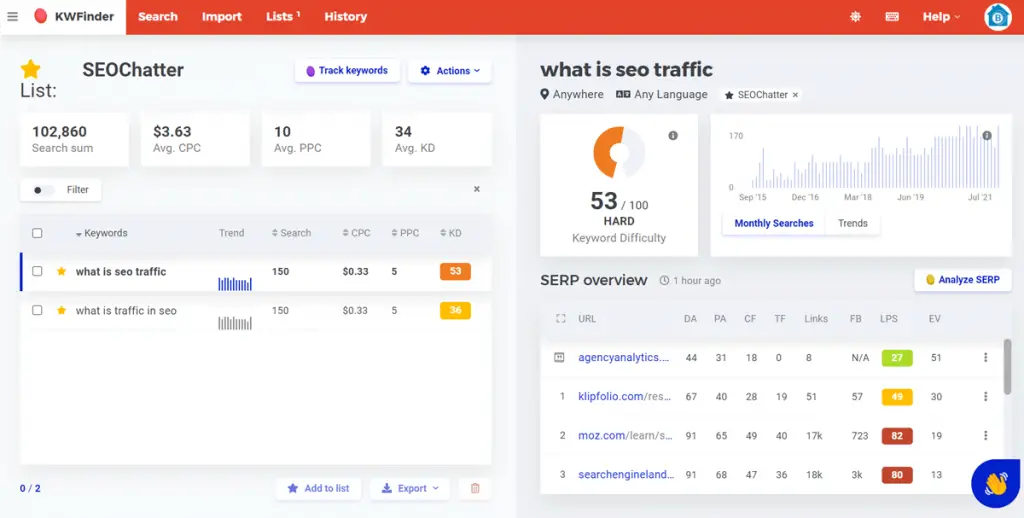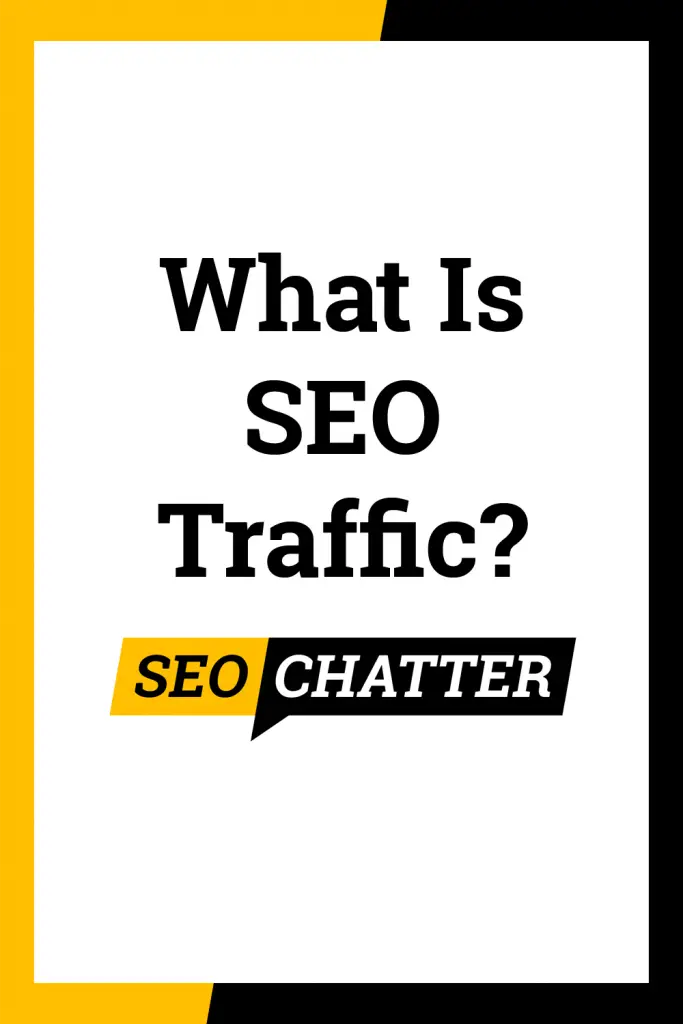In this post, we’ll answer the question, “what is SEO traffic?”
But we’ll explain more than just the definition and meaning of this term. We’ll also go over the importance of traffic in SEO and how to earn more SEO traffic for your business.
As you’ll find out below, search engine optimization (SEO) is the most important factor you can focus on for getting organic traffic to your website, so it pays to know how to do it the right way.

What Is SEO Traffic?
SEO traffic is organic traffic that comes from search engines. SEO traffic relies on search engine optimization methods to get the highest amount of organic traffic possible to a website by bringing it to the top of the search engine results pages.
Why Is SEO Traffic Important?
SEO traffic is important because SEO traffic is free organic traffic that increases your website’s visibility in the search engines. Targeted SEO traffic can be beneficial for every business to gain more leads, customers, and sales from search engines that don’t have to be paid for.
How to Get SEO Traffic
1. Choose the Right SEO Keywords for Traffic
If you want to increase your organic traffic, then you have to do keyword research. You can’t just write a new piece of content about any topic you want and expect to get traffic to your website from it.
The fact is there are specific queries people are actively searching for on Google that relate to your business to which they want the answers. For example, my website is all about SEO. And this post targets the question, “what is SEO traffic?”
I chose to target this keyword for organic SEO traffic for three reasons:
- It directly relates to my business.
- People are actively searching for it on Google.
- It’s not a hard keyword to compete for to get free traffic.
Hopefully, you already know what topics your potential customers are interested in, so we can skip the explanation for #1 above.
But knowing which organic keywords your target visitors are actively searching for in Google as described in reason #2 is important for increasing your organic search traffic.
To find out what those phrases are quickly and easily, you can go to Google to get ideas from its auto-suggestion feature that pops up in the search engine as you type words. See the image below and how this strategy worked to help me come up with the idea for this article you’re reading right now.

Now that you have a better idea of how to find good keywords to target, the next step is to find out how difficult the competition is for those queries to get ranked in the top 10 positions on Google.
For this step, you’ll need access to a keyword research tool like KWFinder by Mangools (try it for free). It’s one of the only SEO tools I recommend as an affiliate because it’s cheap, yet powerful for keyword research.
KWFinder will allow you to uncover two important metrics to better target your SEO traffic:
- Keyword Search Volume: The average number of searches a query gets per month.
- Keyword Difficulty: An estimate for how hard it is to rank on the first page of Google for a query.
You can see an example of how this valuable SEO data looks in the image below.

One thing to note in the image above is that the keyword difficulty score appears to be high. However, after examining the top-ranking pages, I discovered that it’s actually not a hard keyword to compete for at all.
Only the top two competitors are targeting the exact keyword phrase I’m writing about on this page here. The other 10 sites are about the topic of SEO in general; not SEO traffic.
Note: KWFinder is also a good tool for doing SEO analysis for existing pages you want to rank higher in the search engines. See my guide on how to do SEO analysis for a website for more details.
2. Create Content That Meets Search Intent
The next step for how to get SEO traffic is to create high-quality content that meets the search intent of the user.
In my post on what does SERP stand for in SEO, I explain how there are three main categories for queries that show up on the search engine results pages (SERP).
- Informational Queries: These occur when a person wants to find out more about a topic and doesn’t have a specific website or brand in mind. They’re typically typing a question into Google. The article you’re reading here is a good example of a page that meets the needs of an information query.
- Transactional Queries: These occur when a person is thinking of buying a product or service and needs guidance on the purchase. They’re typically typing a general name for a product or service or looking for customer reviews on Google.
- Navigational Queries: These occur when a person is looking for a specific website, product, or service but doesn’t know the direct URL for the company. They’re typically typing the brand name into Google to find the official website.
Knowing about these various search intents will allow you to create content that meets the needs of each type of user.
For example, you wouldn’t want to write a piece of content that is in a question and answer format like this post here if you were targeting a transactional query. Doing so would not increase your SEO traffic.
Instead, you would want to create content that focuses on a specific product or service and explains the complete details and purchasing options.
3. Improve Your On-Page SEO
Now that you know how to do keyword research and meet the search intent for the user, the next step in getting SEO traffic is improving your on-page SEO.
In my post on what is SEO content writing, I explain that without proper on-page SEO techniques in place, your content won’t rank as high on Google for the keywords you’re targeting.
Even the best-written content will not get the visibility it deserves without good on-page optimization. Give it a look if you’re serious about increasing your rankings and traffic. No one else teaches these advanced tips for fast website growth.
You’ll learn how to optimize on-page SEO factors like:
- Meta Title
- Meta Description
- URL
- Header Tags
- Body Content
- Images
- Internal Links
- Navigation Menu
- and more
4. Blog Regularly for More SEO Traffic
Blogging on your website is the most effective way to increase your SEO traffic.
A blog allows you to create an endless amount of content to capture more organic traffic from the search engines.
In my post on why blogs are important for SEO, I share the following benefits of blogging for SEO:
- Increases Organic SEO Volume
- Creates Fresh Content That Gets Rewarded
- Offers Unlimited SEO Keyword Opportunities
- Important for Internal SEO Linking
- Increases Site Authority with Backlinks
- Improves Popularity Rank
- Gains More Traffic with SEO Images
- Builds Credibility for Your Business
5. Use Good Internal Linking
In my guide on the difference between internal links and external links, you learn how links within a website show relationships between content. And these internal links transfer SEO value and importance between pages.
A good internal linking strategy can also boost the search engine rankings for a page’s target keywords because it improves the topical authority for the content.
Testing performed by SEO scientist Kyle Roof found that “2-3 internal links is equal to one external link of the same value.” So you can extract as much ranking power out of your own site before you even need to think about getting backlinks to a page.
A good starting point for increasing SEO traffic with internal linking is to create five contextual links from topically relevant pages that include your main target keyword as an exact match phrase in the anchor text. Then, to prevent overoptimization, add a few filler words into two of those internal links so they’re not a 100% exact match.
Is Traffic Good for SEO?
Traffic is good for SEO because the more popular your site is, the better it can rank in the search engines. Studies show that websites that get more traffic have improved SEO metrics. Search engines like Google prefer to rank content that people like to visit.
One SEO case study in particular showed a strong correlation between a spike in referral traffic and an increase in rankings for an ultra-competitive keyword.
According to CognitiveSEO, “Within 1 day, the organic search traffic on our blog hit 20,000 visits. We had a truly impressive search rankings spike for what is undoubtedly a very competitive phrase (google images), getting from the 74th position to the 8th in Google search results in just one day!”
Although the company couldn’t certify 100% that the rise in traffic increased their Google ranking position, it did report that “it seems like obtaining links that provide a high volume of referrals and click-through data impact search rankings within search engines.”
The other thing to keep in mind here in regards to SEO traffic improvements is that web pages that get more referral traffic from other websites tend to also gain more natural backlinks. And high-quality backlinks are part of the Google ranking algorithm.
So traffic is good for SEO in the sense that it increases exposure for the content, which can then lead to higher rankings in the search engines for its target keywords. If you want to learn more about SEO content, then read my guide on what is SEO content.
I also have a guide on what is an SEO plan if you want to learn how to develop a strategy for long-term growth.
SEO Traffic Summary
I hope you enjoyed this guide explaining what is SEO traffic.
As you discovered, SEO traffic is organic traffic that comes from search engines and it relies on search engine optimization methods to get the highest amount of traffic possible to a website by bringing it to the top of the SERPs. Therefore, focusing on increasing traffic in SEO is very important to the growth of a website because it leads to more customers and sales.


SEO Chatter is dedicated to teaching the fundamentals of search engine marketing to help marketers understand how to increase organic website traffic and improve search engine rankings.
